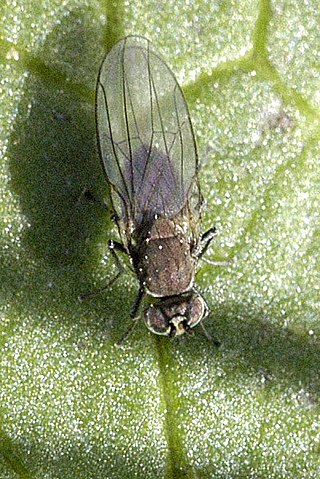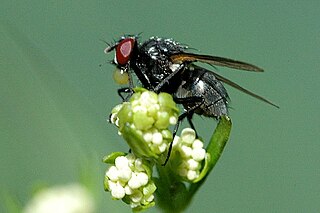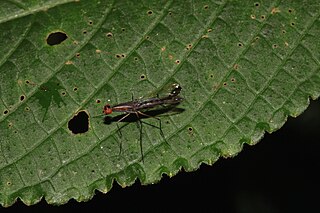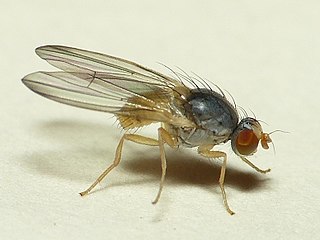
Flies are insects of the order Diptera, the name being derived from the Greek δι- di- "two", and πτερόν pteron "wing". Insects of this order use only a single pair of wings to fly, the hindwings having evolved into advanced mechanosensory organs known as halteres, which act as high-speed sensors of rotational movement and allow dipterans to perform advanced aerobatics. Diptera is a large order containing an estimated 1,000,000 species including horse-flies, crane flies, hoverflies, mosquitoes and others, although only about 125,000 species have been described.

Hoverflies, also called flower flies or syrphids, make up the insect family Syrphidae. As their common name suggests, they are often seen hovering or nectaring at flowers; the adults of many species feed mainly on nectar and pollen, while the larvae (maggots) eat a wide range of foods. In some species, the larvae are saprotrophs, eating decaying plant and animal matter in the soil or in ponds and streams. In other species, the larvae are insectivores and prey on aphids, thrips, and other plant-sucking insects.

A crane fly is any member of the dipteran superfamily Tipuloidea, which contains the living families Cylindrotomidae, Limoniidae, Pediciidae and Tipulidae, as well as several extinct families. "Winter crane flies", members of the family Trichoceridae, are sufficiently different from the typical crane flies of Tipuloidea to be excluded from the superfamily Tipuloidea, and are placed as their sister group within Tipulomorpha.

The Tachinidae are a large and variable family of true flies within the insect order Diptera, with more than 8,200 known species and many more to be discovered. Over 1,300 species have been described in North America alone. Insects in this family commonly are called tachinid flies or simply tachinids. As far as is known, they all are protelean parasitoids, or occasionally parasites, of arthropods, usually other insects. The family is known from many habitats in all zoogeographical regions and is especially diverse in South America.

The Bombyliidae are a family of flies, commonly known as bee flies. Adults generally feed on nectar and pollen, some being important pollinators. Larvae are mostly parasitoids of other insects.

The Phoridae are a family of small, hump-backed flies resembling fruit flies. Phorid flies can often be identified by their escape habit of running rapidly across a surface rather than taking to the wing. This behaviour is a source of one of their alternate names, scuttle fly. Another vernacular name, coffin fly, refers to Conicera tibialis. About 4,000 species are known in 230 genera. The most well-known species is cosmopolitan Megaselia scalaris. At 0.4 mm in length, the world's smallest fly is the phorid Euryplatea nanaknihali.

Ephydridae is a family of insects in the order Diptera.
The Nymphomyiidae are a family of tiny (2 mm) slender, delicate flies (Diptera). Larvae are found among aquatic mosses in small, rapid streams in northern regions of the world, including northeastern North America, Japan, the Himalayas, and eastern Russia. Around a dozen extant species are known, with two fossil species found in amber, extending back to the Mid Cretaceous. Under an alternative classification, they are considered the only living representatives of a separate, suborder called Archidiptera which includes several Triassic fossil members. The family has characteristics associated with the Nematocera as well as the Brachycera. The antennae are shortened as in the Brachycera and these flies are long, having a snout with vestigeal mouthparts, non-differentiated abdominal segments with large cerci. The wings are narrow and hair-fringed and have very weak venation. They are known to form cloud-like swarms in summer and the short-lived non-feeding adults have wings that fracture at the base shortly after mating.

The Micropezidae are a moderate-sized family of acalyptrate muscoid flies in the insect order Diptera, comprising about 500 species in about 50 genera and five subfamilies worldwide,. They are most diverse in tropical and subtropical habitats, especially in the Neotropical Region.

The Lonchaeidae are a family of acalyptrate flies commonly known as lance flies. 610 described species are placed into 10 genera. These are generally small but robustly built flies with blue-black or metallic bodies. They are found, most commonly in wooded areas, throughout the world with the exception of polar regions and New Zealand. Details of the distribution of genera and species by biogeographic realm are included in the World Catalogue of the family Lonchaeidae

Pallopteridae is a family of flies. The various species are collectively called flutter-wing flies, trembling-wing, or waving-wing flies, because of the striking vibration of the wings in many species. Over 70 species in about 15 genera are found in the temperate regions of the Northern and Southern Hemispheres.

Hydrotaea is a genus of insects in the housefly family, Muscidae. They occur in most regions of the world but are more populous in warmer climates. They are often found on feces in summer months, and are therefore generally found in close proximity to livestock. Among the 130 known species in this genus, one of the most commonly recognized is the dump fly.

Muscina is a genus of flies that belongs to the family Muscidae, currently consisting of 27 species. They are worldwide in distribution and are frequently found in livestock facilities and outside restrooms. The most common species are M. stabulans, M. levida, and M. prolapsa. Muscina flies commonly breed in manure and defecate on food, which has been linked to the spread of some disease and illnesses. The occurrence of Muscina larvae on dead bodies has led to their regular use in forensic investigations, as they may be used to estimate the time of death. Research have shown the prevalence of certain species of Muscina flies as vectors of diseases such as poliomyelitis.

Anastrepha ludens, the Mexican fruit fly or Mexfly, is a species of fly of the Anastrepha genus in the Tephritidae family. It is closely related to the Caribbean fruit fly Anastrepha suspensa, and the papaya fruit fly Anastrepha curvicauda.
Diptera is an order of winged insects commonly known as flies. Diptera, which are one of the most successful groups of organisms on Earth, are very diverse biologically. None are truly marine but they occupy virtually every terrestrial niche. Many have co-evolved in association with plants and animals. The Diptera are a very significant group in the decomposition and degeneration of plant and animal matter, are instrumental in the breakdown and release of nutrients back into the soil, and whose larvae supplement the diet of higher agrarian organisms. They are also an important component in food chains.

The family Nothybidae contains only the genus Nothybus, a group of colorful and elongated flies. The family has been recently revised.

Palloptera ustulata is a species of fly in the family Pallopteridae. It is found in the Palearctic The wings are diffusely shaded brown with a darker tip. The back of the head is largely black.The face and antennae are yellow.The thorax is black with a fairly long whitish pilosity .The legs,tarsi and halteres are yellowish.Long. : 4 mm.The larvae develop under the bark of deciduous trees. It is part of a species complex and difficult to determine with certainty.

Toxonevra is a genus of flutter flies in the family Pallopteridae. There are about eight described species in Toxonevra.
Criorhina nigriventris , the Bare-cheeked Bumble Fly, is an uncommon species of syrphid fly observed across the northern United States, the Appalachian Mountains and southern Canada. Hoverflies can remain nearly motionless in flight. The adults are also known as flower flies for they are commonly found on flowers, from which they get both energy-giving nectar and protein-rich pollen. The larvae of this genus are found in decaying wood.
Total of 245 species either found or highly expected to be found in New York.

















